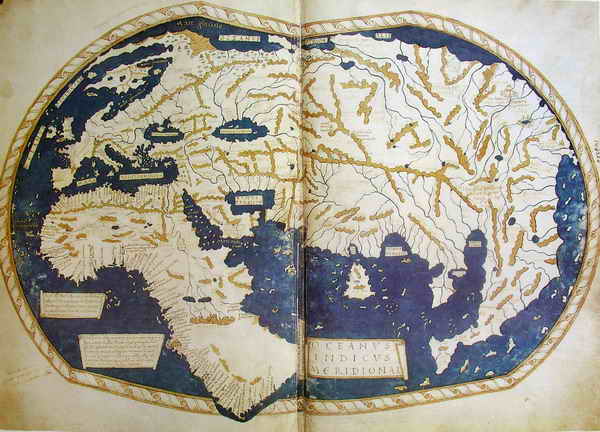 |
| The "Great American Desert" notation of the Great Plains from Maj. Stephen Long's expedition. |
17 October 2014
SHD Members talk about Mapping the U.S.
A new issue of the SHD newsletter Terrae Cognita
The latest issue of the SHD newsletter Terrae Cognita has been published here. You'll find abstracts for the upcoming meeting in Austin, and other member news. Happy reading!
Uncovering Hidden Text on a 500-Year-Old Map That Guided Columbus
 |
| World map of Henricus Martellus Germanus from 1489, currently at the British Library. |
10 September 2014
Franklin's Lost Expedition Found
 |
| Man Proposes, God Disposes by Edwin Henry Landseer, 1864. Source: Wikimedia Commons |
- Lost Franklin expedition ship found in the Arctic at CBC News
- Sir John Franklin: Fabled Arctic ship found at BBC News
11 August 2014
The Ninth Biennial Virginia Garrett Lectures on the History of Cartography
The link below is the announcement and registration brochure for the 2014 Virginia Garrett Lectures on the History of Cartography/Map Fair of the West.
13 July 2014
55th Annual Meeting of the Society for the History of Discoveries
Preliminary information of the 55th Annual Meeting of the Society for the History of Discoveries to be held 30 October - 2 November 2014 in Austin, Texas is available at: http://www.sochistdisc.
17 May 2014
The wreck of Columbus's flagship found?
 |
| The anchor of the Santa María now rests in the Musée du Panthéon National Haïtien, in Port-au-Prince, Haiti. |
The ship was wrecked on Christmas Eve, 1492, and sank the next day, after a cabin boy was allowed to steer because all the other sailors were asleep from the festivities of the day. Columbus ordered the deck timbers salvaged to create the first European settlement in the Caribbean, named La Navidad ("Christmas"). Archaeological evidence has located La Navidad nearby.
Clifford believes the remains of the Santa María are lodged on a coral reef about ten to fifteen feet below the water's surface. Photos of the site in 2003 show a lombard canon, which Clifford avers has now been looted from the site. Clifford says that, "All the geographical, underwater topography and archaeological evidence strongly suggests that this wreck is Columbus' famous flagship, the Santa Maria."
Laurence Bergreen, author of Columbus: The Four Voyages, is more skeptical. He wonders how much of the ship would remain, given its age, the influence of earthquakes and hurricanes, and that most of the wood from the ship was used for La Navidad (and want was not used for lumber, he believes, would have rotted away). Bergreen also comments on the lombard canon from 2003 have disappeared: "But now the lombards, if that's what they were, are gone. There's not much left to go on."
Clifford has tried to interest the Haitian government in protecting and excavating the site. He said, "The Haitian government has been extremely helpful–and we now need to continue working with them to carry out a detailed archaeological excavation of the wreck." Bergreen agrees that more investigation is needed: "Given its potential historic significance, let's hope this wreck will finally receive the careful and responsible attention it deserves."
- "Has Wreckage of Christopher Columbus’ Flagship Been Found?" by Barbara Maranzani, History.com
- "Exclusive: Found after 500 years, the wreck of Christopher Columbus’s flagship the Santa Maria," by David Keys, The Independent (UK)
- "Has the ship Columbus discovered the New World in been found? Wreck found off the coast of Haiti believed to be 500 year old Santa Maria" by Mark Prigg, Daily Mail
- "Columbus’ Santa Maria has been already been LOOTED: Diver who claims to have found 500-year-old wreck says ship must be preserved immediately," by Darren Boyle, Daily Mail
- "Is shipwreck really the Santa Maria?" by Laurence Bergreen, CNNOpinion
Subscribe to:
Posts (Atom)

